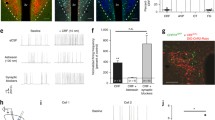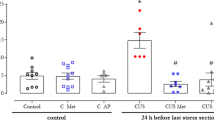Abstract
The activation of the HPA axis is the endocrine measure of stress responsiveness that is initiated by corticotropin-releasing hormone (CRH). CRH exerts its effects via CRHR1 and CRH-R2 receptors coupled to the cAMP signaling system and this process involves transcription factor cAMP-responsive element-binding protein (CREB).This study investigated the role of CRH and the possible involvement of CREB in gene regulation of CRH receptor, under basal conditions and after stress application in the pituitary. We used wild type (wt +/+) controls and CRH knock-out (CRH-KO −/−) male mice. Using CRH-deficient mice, we were able to investigate the consequences of the lack of the CRH on the expression of CRH receptors and transcriptional regulation mediated by CREB. We estimated the effect of acute (IMO 1×) and repeated (IMO 7×) restraint stressors lasting 30 and 120 min on the expression of mRNA CREB, CRH-R1, and CRH-R2 by qPCR. We found very significant difference in the expression of these peptides under the effect of single and repeated stress in control and CRH-KO mice. Our results indicate that both CRH receptors and CREB might be involved in the regulation of stress response in the pituitary of mice. We propose that regulation of the stress response may be better understood if more were known about the mechanisms of CRH receptor signal transduction and involvement of CREB system.


Similar content being viewed by others
References
Aguilera G (1998) Corticotropin releasing hormone, receptor regulation and the stress response. Trends Endocrinol Metab 9:329–336
Aguilera G, Liu Y (2012) The molecular physiology of CRH neurons. Front Neuroendocrinol 33:67–84
Aguilera G, Nikodemova M, Wynn PC, Catt KJ (2004) Corticotropin releasing hormone receptors: two decades later. Peptides 25:319–329 Review
Altarejos JY, Montminy M (2011) CREB and the CRTC co-activators: sensors for hormonal and metabolic signals. Nat Rev Mol Cell Biol 12:141–151
Bustin SA, Benes V, Garson JA, Hellemans J, Huggett J, Kubista M, Mueller R, Nolan T, Pfaffl MW, Shipley GL, Vandesompele J, Wittwer CT (2009) MIQE guidelines: minimum information for publication of quantitative real-time PCR experiments. Clin Chem 55:611–622
Cope JL, Regev L, Chen Y, Korosi A, Rice CJ, Ji S et al (2013) Differential contribution of CBP:CREB binding to corticotropin-releasing hormone expression in the infant and adult hypothalamus. Stress 17:39–50
Coste SC, Kesterson RA, Heldwein KA, Stevens SL, Heard AD, Hollis JH, Murray SE, Hill JK, Pantely GA, Hohimer AR, Hatton DC, Phillips TJ, Finn DA, Low MJ, Rittenberg MB, Stenzel P, Stenzel-Poore MP (2000) Abnormal adaptations to stress and impaired cardiovascular function in mice lacking corticotropin-releasing hormone receptor-2. Nat Genet 24:403–409
Dautzenberg FM, Hauger RL (2002) The CRF peptide family and their receptors: yet more partners discovered. Trends Pharmacol Sci 23:71–77
Filipcik P, Novak P, Mravec B, Ondicova K, Krajciova G, Novak M, Kvetnansky R (2012) Tau protein phosphorylation in diverse brain areas of normal and CRH deficient mice: up-regulation by stress. Cell Mol Neurobiol 32:837–845
Greetfeld M, Schmidt MV, Ganea K, Sterlemann V, Liebl C, Müller MB (2009) A single episode of restraint stress regulates central corticotrophin-releasing hormone receptor expression and binding in specific areas of the mouse brain. J Neuroendocrinol 21:473–480
Hebert MA, Serova LI, Sabban EL (2005) Single and repeated immobilization stress differentially trigger induction and phosphorylation of several transcription factors and mitogen-activated protein kinases in the rat locus coeruleus. J Neurochem 95:484–498
Heinrichs SC, Koob GF (2004) Corticotropin-releasing factor in brain: a role in activation, arousal, and affect regulation. J Pharmacol Exp Ther 311:427–440
Itoi K, Horiba N, Tozawa F, Sakai Y, Sakai K, Abe K, Demura H, Suda T (1996) Major role of 3′,5′-cyclic adenosine monophosphate-dependent protein kinase A pathway in corticotropin-releasing factor gene expression in the rat hypothalamus in vivo. Endocrinology 137:2389–2396
Kageyama K, Li Ch, Vale WW (2003) Corticotropin-releasing factor receptor type 2 messenger ribonucleic acid in rat pituitary: localization and regulation by immune challenge, restraint stress, and glucocorticoids. Endocrinology 144:1524–1532
Kasagi Y, Horiba N, Sakai K, Fukuda Y, Suda T (2002) Involvement of cAMP-response element binding protein in corticotropin-releasing factor (CRF)-induced down-regulation of CRF receptor 1 gene expression in rat anterior pituitary cells. J Neuroendocrinol 14:587–592
Kishimoto T, Radulovic J, Radulovic M, Lin CR, Schrick C, Hooshmand F, Hermanson O, Rosenfeld MG, Spiess J (2000) Deletion of crhr2 reveals an anxiolytic role for corticotropin-releasing hormone receptor-2. Nat Genet 24:415–419
Klenerova V, Sery O, Hynie S (2008) Corticotropin-releasing hormone receptor subtypes in the rat anterior pituitary after two types of restraint stress. Ann N Y Acad Sci 1148:415–420
Klenerova V, Chottova-Dvorakova M, Skopek P, Sida P, Mistrova E, Slavikova J, Hynie S (2011) Expression of heart oxytocin receptor and its mRNA in two rat strains with different activity of HPA axis. Neuroendocrinol Lett 32:805–810
Klenerová V, Jurcovicová J, Kaminský O, Sída P, Krejcí I, Hlinák Z, Hynie S (2003) Combined restraint and cold stress in rats: effects on memory processing in passive avoidance task and on plasma levels of ACTH and corticosterone. Behav Brain Res 142:143–149
Klenerová V, Sída P, Krejcí I, Hlinák Z, Hynie S (2007) Effects of two types of restraint stress on spontaneous behavior of Sprague-Dawley and Lewis rats. J Physiol Pharmacol 58:83–94
Kvetnansky R, Mikulaj L (1970) Adrenal and urinary catecholamines in rats during adaptation to repeated immobilization stress. Endocrinology 87:738–743
Kvetnanský R, Krizanova O, Tillinger A, Sabban EL, Thomas SA, Kubovcakova L (2008) Regulation of gene expression of catecholamine biosynthetic enzymes in dopamine-beta-hydroxylase- and CRH-knockout mice exposed to stress. Ann N Y Acad Sci 1148:257–268
Liu Y, Kalintchenko N, Sassone-Corsi P, Aguilera G (2006) Inhibition of corticotrophin-releasing hormone transcription by inducible cAMP-early repressor in the hypothalamic cell line, 4B. J Neuroendocrinol 18:42–49
Liu Y, Coello AG, Grinevich V, Aguilera G (2010) Involvement of transducer of regulated cAMP response element-binding protein activity on corticotropin releasing hormone transcription. Endocrinology 151:1109–1118
Livak KJ, Schmittgen TD (2001) Analysis of relative gene expression data using real-time quantitative PCR and the 2(-Delta Delta C(T)) Method. Methods 25:402–408
Majzoub JA (2006) Corticotropin-releasing hormone physiology. Eur J Endocrinol 155:S71–S76
Martí O, Armario A (1997) Influence of regularity of exposure to chronic stress on the pattern of habituation of pituitary-adrenal hormones, prolactin and glucose. Stress 1:179–189
Molina CA, Foulkes NS, Lalli E, Sassone-Corsi P (1993) Inducible and negative autoregulation of CREM: an alternative promoter directs the expression of ICER, an early response repressor. Cell 75:875–886
Muglia L, Bethin KE, Jacobson L, Majzoub JA (2000) Pituitary-adrenal axis regulation in CRH-deficient mice. Endocr Res 26:1057–1066
Nikodemova M, Diehl CR, Aguilera G (2002) Multiple sites of control of type-1 corticotropin releasing hormone receptor levels in the pituitary. Arch Physiol Biochem 110:123–128
Nostramo R, Tillinger A, Saavedra JM, Kumar A, Pandey V, Serova L, Kvetnansky R, Sabban EL (2012) Regulation of angiotensin II type 2 receptor gene expression in the adrenal medulla by acute and repeated immobilization stress. J Endocrinol 215:291–301
Ortega-Martínez S (2015) A new perspective on the role of the CREB family of transcription factors in memory consolidation via adult hippocampal neurogenesis. Front Mol Neurosci 8:46–58 Review
Pacák K, Palkovits M (2001) Stressor specificity of central neuroendocrine responses: implications for stress-related disorders. Endocr Rev 22:502–548 Review
Pfaffl MW, Horgan GW, Dempfle L (2002) Relative expression software tool (REST) for group-wise comparison and statistical analysis of relative expression results in real-time PCR. Nucleic Acids Res 30:e36
Sabban EL, Kvetnansky R (2001) Stress-triggered activation of gene expression in catecholaminergic systems: dynamics of transcriptional events. Trends in Neurosci 24:91–98
Slavikova J, Mistrova E, Klenerova V, Kruzliak P, Caprnda M, Hynie S, Sida P, Chottova Dvorakova M (2016) Effects of immobilizations stress with or without water immersion on the expression of atrial natriuretic peptide in the hearts of two rat strains. Am J Transl Res 8:3148–3158
Trnecková L, Armario A, Hynie S, Sída P, Klenerová V (2006) Differences in the brain expression of c-fos mRNA after restraint stress in Lewis compared to Sprague-Dawley rats. Brain Res 1077:7–15
Trnecková L, Rotllant D, Klenerová V, Hynie S, Armario A (2007) Dynamics of immediate early gene and neuropeptide gene response to prolonged immobilization stress: evidence against a critical role of the termination of exposure to the stressor. J Neurochem 100:905–914
Venihaki M, Majzoub JA (1999) Animal models of CRH deficiency. Front Neuroendocrinol 20:122–145
Acknowledgements
This work was supported by the Grants PROGRES Q25/LF1 and SVV 260377 from Charles University, Prague, Czech Republic.
Author information
Authors and Affiliations
Corresponding author
Ethics declarations
Conflicts of interest
The authors declare no conflicts of interest.
Rights and permissions
About this article
Cite this article
Klenerova, V., Kvetnansky, R. & Hynie, S. The Effect of Acute and Repeated Stress on CRH-R1 and CRH-R2 mRNA Expression in Pituitaries of Wild Type and CRH Knock-Out Mice. Cell Mol Neurobiol 38, 163–169 (2018). https://doi.org/10.1007/s10571-017-0556-3
Received:
Accepted:
Published:
Issue Date:
DOI: https://doi.org/10.1007/s10571-017-0556-3




